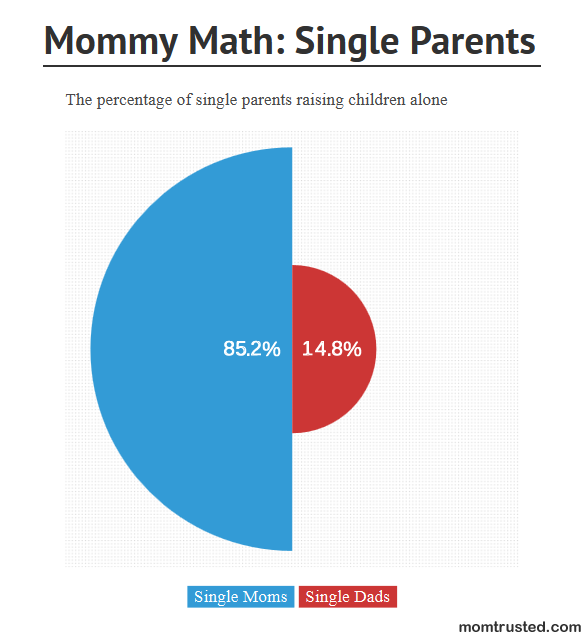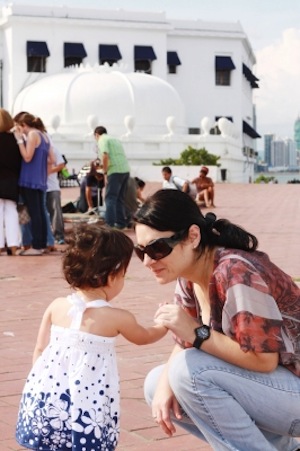Keeping Kids Safe this Holiday Season
From hot ovens to broken glass ornaments, there are plenty of safety hazards around the holidays. MomTrusted came up with some simple tips to help keep children safe this season.
Invest in an artificial tree.
Avoid the real deal this year and invest in a fake tree. Real ones pose as a serious fire hazard, but buying a fire resistant artificial one will help keep the flames away. Miss the process of picking one out and cutting it down? Take the kids on a winter hike instead. You can still go stomp around in the snow and smell fresh pine, but you won’t get stuck with the process of lugging a tree home. Collect pinecones, on your hike, to decorate with instead of a gigantic tree.
Bundle up.
Little ones love to play in the snow. Encourage them to make snow angels and build snowmen, but make sure they’re bundled from head to toe first. Frostbite is not something you want to mess. Also invest in gloves with sleeves attached. Not only will these keep snow from creeping up your children’s sleeves, but they’ll be much more difficult for the little ones to pull off when they’re playing outdoors.
Avoid tunneling through the snow.
Snow tunnels and igloos may seem fun, but if the snow caves in, little tunnelers could end up trapped or worse. Tightly packed snow can result in suffocation.
Keep ornaments high.
Shiny ornaments can catch the eyes of little ones quickly and before you know it, you can have tiny hands grabbing for them. Keep them far out of reach to avoid tipped trees and broken class. You may even want to place even non-breakable ones high too. Little piece can be choking hazards and pointy hooks should be kept completely out of reach.
Buy new garland.
Did you know that old garland often contains lead, a main reason for many of today’s toy recalls?
Use lights, not candles.
Enough said.
Sources:
-“Holiday decoration safety smarts.” Baby Zone.
-Photo courtesy of Tom Clare/freedigitalphotos.net
Mommy Math: Single Parents
We live in a country where single parenting is far from rare. In the U.S., there are 13.6 million single parents and 21.2 million children being raised by only one parent. That makes up 26% of young people and children in the country. While it used to rest primarily in the mother’s hands to care for a child, the amount of single fathers had grown 60% in the last decade. However, despite the large growth in single fathers raising children, single moms are still much more common.
Sources:
-“Single Parent Statistics” Single Parent
-“Single Mother Statistics” Single Mother Guide
5 Discipline Tips for Toddlers
Trust us, we know there’s a reason for the phrase, “the terrible twos.” But good disciplining can help tame the twos, making your life easier and teaching your little one important discipline skills for later in life. Here are some tips on the often-confusing practice of teaching good behavior:
Tell the truth.
Avoid lies at all costs. It may be tempting to tell what seems like a white lie (ie: “Don’t go past that fence because there’s a monster on the other side.”) But young kids are extremely prone to repeating anything and everything that comes out of your mouth. Imagine explaining to your neighbor why your little one thinks he or she is a monster. It’s better just to tell the truth.
Remain consistent.
It holds true for everything from naps to snack time: toddlers do best with routine and order. It makes them feel safe, secure and helps them learn faster. If your child does something they shouldn’t, remind them not to and continue to do so each time they do afterward-even if you’re tired and it would be easier just to let them get away with it. Remember, “just this one time” is not a concept that toddlers easily grasp.
A little bribing never hurt anyone.
A lot of parents advise against bribing and it’s true that too much bribing can lead to spoiling, but there’s no harm in having a couple good bribes up your sleeve. Just remember that reinforcing good behavior is always better than discouraging bad so keep things positive. For example, instead of saying “If you stop that, I’ll give you a piece of candy,” say “We’ll go to the park after we go to the grocery store.”
Follow your own rules.
It’s a lot easier to say, “We only eat in the kitchen” than it is to say “You only eat in the kitchen, but mom can eat in front of the TV sometimes.” Set an example by following your own rules.
Avoid the need to discipline in the first place.
You know what gets your toddler worked up so avoid those stressful situations whenever possible. Make sure you don’t miss a nap or meal. Generally speaking, the less crabby toddlers are, the better they listen.
Sources:
-“7 Secrets of Toddler Discipline.” WebMD
-“8 Discipline Mistakes Parents Make.” Parenting.com
-Photo courtesy of David Castillo Dominici/freedigitalphotos.net
New Study Shows Pacifiers May Stunt Emotional Growth in Boys
Researchers at the University of Wisconsin, Madison found that pacifiers might stunt emotional development, but only in boys. Psychologists at Wisconsin led three experiments connected low emotional maturity to heavy pacifier use as a child.
Psychologists believe the nookies may make it difficult to imitate adult’s facial expressions, a skill that children are perfecting at the binky age. The theory held true for both the six and seven-year-olds and college-aged males that the researchers studied.
The six and seven-year-olds were measured by the amount they mimicked expressions on a video and college males took perspective taking tests. Both experiments were meant to mimic empathy. And in both cases, those who reported heavy pacifier use as children scored lower.
Girls, however, showed no direct correlations between emotional maturity and pacifier use as a child. It may be due to the fact that girls tend to develop earlier, but the reason remains a mystery.
This problem only occurs when facial expressions are being utilized. During times like nap and bedtimes, children are sleeping so expression mimicking is not happening. So even though it may be wise to wean boys off of binkies, this doesn’t mean that parents of baby boys should ditch pacifiers completely.
Sources:
-University of Wisconsin, Madison news releases. 9/18/12.
-Photo courtesy of Carlos Porto/freedigitalphotos.net
Kids Nightmares: What Causes Them and How to Handle Them
Right around preschool-age, children start recognizing that nightmares are only dreams and cannot hurt them. This does not mean your child is any less scared. Your little one still needs your reassurance and understanding. Here’s a little bit of information about what may be causing his or her bad dreams and what you can do to help:
What causes nightmares?
1. An active imagination could be part of the reason your child wakes up in a cold sweat. Preschoolers use their imagination to make sense of the world around them. It can be used as their way of working through new information.
2. Children at this age have difficulty separating reality from make believe. They may believe in the Bogeyman as much as they believe in Santa Claus, making their nightmares that much more realistic.
3. Stress can trigger nightmares and stress is often a result of change at this age. Starting preschool is a huge change in preschoolers’ lives so a sense of worry and stress is only natural.
4. If something traumatic has recently happened in your child’s life, that could be the perpetrator. If there was a recent car accident or severe injury, nightmares could be a natural effect.
How can you help?
1. Help your child calm down as much as you can. Even though he or she is worked up, it’s important that they lose as little sleep as possible.
2. Try asking your kiddo what the dream was about and then use simple logic to explain that it was only a dream and, even though it was certainly scary, it wasn’t real and can’t hurt them.
3. When talking about the nightmare, keep it short and simple. You want to listen and reassure your little one, but you don’t want to spark their imagination and trigger any new nightmares.
4. Try soothing you child by rubbing his or her back, singing them a song or maybe just giving them a huge hug.
5. Prevent nightmares in the first place by sticking to a bedtime routine. Whether this includes reading a book, telling a story or singing a song, follow the same pattern nightly. Routine creates a sense of safety.
Sources:
-“Nightmares.” Kids Health.
-“Nightmares.” What to Expect.
-Photo courtesy of Jeanne Claire Maarbes/freedigitalphotos.net
Extreme Parenting: 360 Degrees Longitude, the Family That Traveled Around the World
 John, September, Jordan and Katrina Higham at Machu Picchu
John, September, Jordan and Katrina Higham at Machu Picchu
John Higham, his wife September and their two children Katrina and Jordan took one full year to travel around the world. During their time on the road, water and in the air, they saw 28 countries on five continents. Higham wrote 360 Degrees Longitude, a book documenting the family’s journey. He talked with MomTrusted about his family trip.
MomTrusted: How did you decide to take a trip around the world?
John Higham: Before our children were born, my wife and I spent a year in Japan on a work assignment. We had traveled previously, and knew what a life changing impact traveling can have on a person. Nevertheless, that year in Japan was the genesis for wanting to take our kids abroad for a year. Initially, we were going to travel to four places and spend three months in each place. It grew from there. See “Chapter Zero.” [in 360 Degrees Longitude]
MomTrusted: How did you budget for the trip?
John: About three years before our RTW [around the world] trip, we took a month-long “prototype trip” to the most expensive place we could think of: Switzerland. From that we scaled the budget for 12 months and for other less expensive locales.
For more information, visit the family’s website.
MomTrusted: How did you choose the countries you visited?
John: Initially, we were going to cycle from London to Istanbul over summer, and from there the plan was to follow the sun (stay in warm weather) to Africa, Asia and South America. This worked out, but we really screwed up in a few places by arriving in what I thought would be a shoulder season [the time between high and low season in a travel market], but it turned out to be freaking cold. Of course, cycling didn’t work out so well after my daughter broke her leg….
Also, we wanted our kids to have some ownership in the trip. A few years before we left, we started putting sticky notes on a giant map and discussing those places as a family. We let the kids pick one destination each. My son picked China to see the Great Wall (he had studied it in school) and my daughter picked Tanzania because of her love of lions.
MomTrusted: How old were your children at the time?
John: Eight and 11. In our prototype trip, we concluded that there were long periods of time where there wasn’t much to do so we wanted our kids to be old enough to keep themselves entertained with a book. They also couldn’t be too old where hanging out with the ‘rents was embarrassing.
MomTrusted: What was the biggest challenge of bringing kids along on your journey?
John: I’m struggling here. There were far more rewards than challenges… stuff management, maybe. You just have more stuff, but the adults tend to manage most of it from hand washing their clothes to helping them spell a word when they write in their journal. Also, finding the time for meaningful homeschooling.
MomTrusted: Tell me about a time that you really wanted to jump on the next plane home.
John: Never happened. Never. The thought did creep into the shadows of our minds after Katrina broke her leg, but my wife and I each gave each other that look and both knew what the other was thinking. It wasn’t even discussed, except in terms of “we have to cope because we’re not going home.” Many friends even offered refuge in various cities across Europe, but we soldiered on.
MomTrusted: What is one of the most valuable lessons you learned on your journey?
John: I never planned to write a book. I’m an engineer by training and profession. But when friends would ask questions like, “what was your take-away?” the responses felt so vacuous that summing up my thoughts in a book was natural.
But if I were to pick two things, they would be that as a family, you can overcome any obstacle as long as you share common goals and do it together and that around the world, people are more alike than they are different. Media tries to amplify the differences and it is very divisive. Travel is a great humanizer.
MomTrusted: If you could, would you do it all over again?
John: Oh, yeah. Even 6+ years later, it occupies my thoughts every waking moment. I yearn to do it again, this time with just my wife. And maybe the occasional visit from kids and grandkids (which had better still be 10 years in the future!).

















